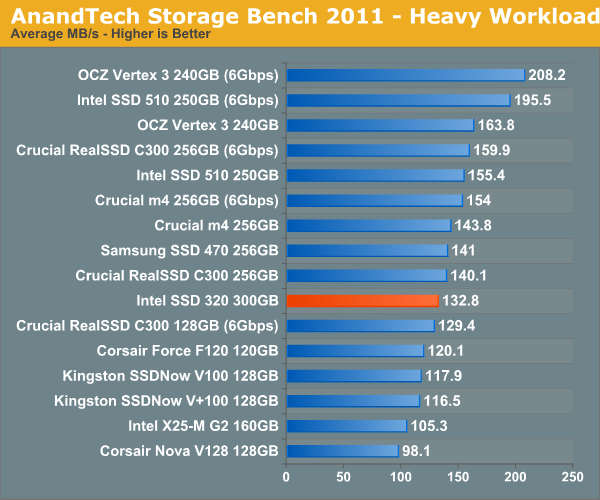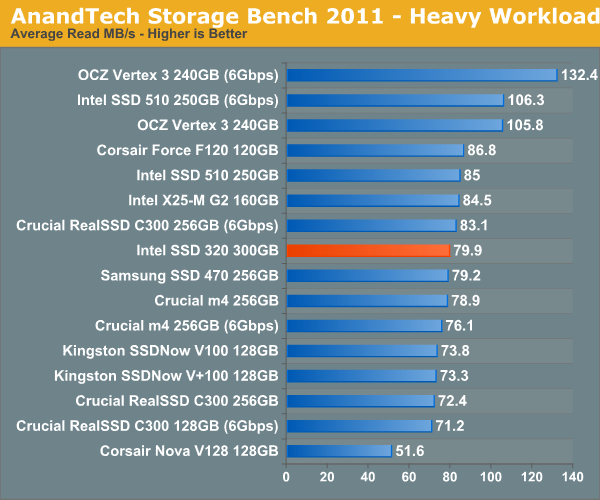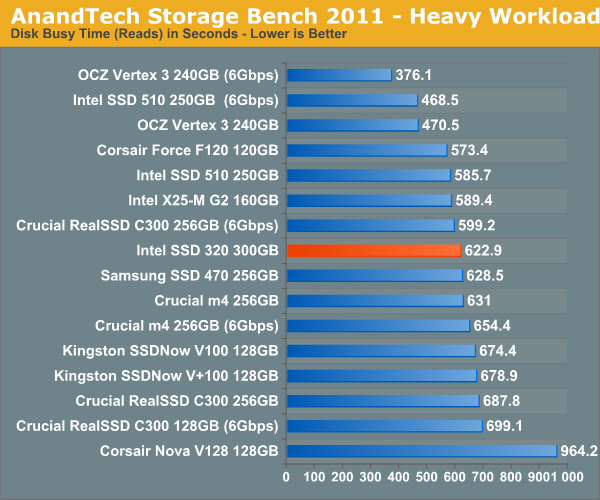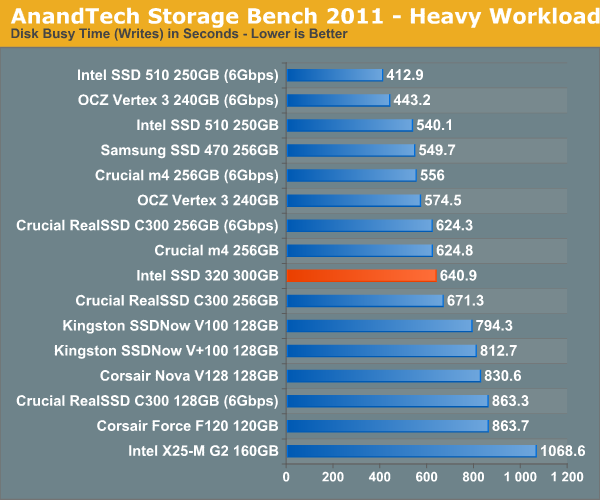The Intel SSD 320 Review: 25nm G3 is Finally Here
by Anand Lal Shimpi on March 28, 2011 11:08 AM EST- Posted in
- IT Computing
- Storage
- SSDs
- Intel
- Intel SSD 320
AnandTech Storage Bench 2011: Much Heavier
I didn't expect to have to debut this so soon, but I've been working on updated benchmarks for 2011. Last year we introduced our AnandTech Storage Bench, a suite of benchmarks that took traces of real OS/application usage and played them back in a repeatable manner. I assembled the traces myself out of frustration with the majority of what we have today in terms of SSD benchmarks.
Although the AnandTech Storage Bench tests did a good job of characterizing SSD performance, they weren't stressful enough. All of the tests performed less than 10GB of reads/writes and typically involved only 4GB of writes specifically. That's not even enough exceed the spare area on most SSDs. Most canned SSD benchmarks don't even come close to writing a single gigabyte of data, but that doesn't mean that simply writing 4GB is acceptable.
Originally I kept the benchmarks short enough that they wouldn't be a burden to run (~30 minutes) but long enough that they were representative of what a power user might do with their system.
Not too long ago I tweeted that I had created what I referred to as the Mother of All SSD Benchmarks (MOASB). Rather than only writing 4GB of data to the drive, this benchmark writes 106.32GB. It's the load you'd put on a drive after nearly two weeks of constant usage. And it takes a *long* time to run.
I'll be sharing the full details of the benchmark in some upcoming SSD articles but here are some details:
1) The MOASB, officially called AnandTech Storage Bench 2011 - Heavy Workload, mainly focuses on the times when your I/O activity is the highest. There is a lot of downloading and application installing that happens during the course of this test. My thinking was that it's during application installs, file copies, downloading and multitasking with all of this that you can really notice performance differences between drives.
2) I tried to cover as many bases as possible with the software I incorporated into this test. There's a lot of photo editing in Photoshop, HTML editing in Dreamweaver, web browsing, game playing/level loading (Starcraft II & WoW are both a part of the test) as well as general use stuff (application installing, virus scanning). I included a large amount of email downloading, document creation and editing as well. To top it all off I even use Visual Studio 2008 to build Chromium during the test.
Many of you have asked for a better way to really characterize performance. Simply looking at IOPS doesn't really say much. As a result I'm going to be presenting Storage Bench 2011 data in a slightly different way. We'll have performance represented as Average MB/s, with higher numbers being better. At the same time I'll be reporting how long the SSD was busy while running this test. These disk busy graphs will show you exactly how much time was shaved off by using a faster drive vs. a slower one during the course of this test. Finally, I will also break out performance into reads, writes and combined. The reason I do this is to help balance out the fact that this test is unusually write intensive, which can often hide the benefits of a drive with good read performance.
There's also a new light workload for 2011. This is a far more reasonable, typical every day use case benchmark. Lots of web browsing, photo editing (but with a greater focus on photo consumption), video playback as well as some application installs and gaming. This test isn't nearly as write intensive as the MOASB but it's still multiple times more write intensive than what we were running last year.
As always I don't believe that these two benchmarks alone are enough to characterize the performance of a drive, but hopefully along with the rest of our tests they will help provide a better idea.
The testbed for Storage Bench 2011 has changed as well. We're now using a Sandy Bridge platform with full 6Gbps support for these tests. All of the older tests are still run on our X58 platform.
AnandTech Storage Bench 2011 - Heavy Workload
We'll start out by looking at average data rate throughout our new heavy workload test:

Overall performance is decidedly last generation. The 320 is within striking distance of the 510 but is slower overall in our heavy workload test.
The breakdown of reads vs. writes tells us more of what's going on:


The next three charts just represent the same data, but in a different manner. Instead of looking at average data rate, we're looking at how long the disk was busy for during this entire test. Note that disk busy time excludes any and all idles, this is just how long the SSD was busy doing something:













194 Comments
View All Comments
Drag0nFire - Monday, March 28, 2011 - link
I have read with interest the comments in previous SSD articles. Actually, though, I am specifically interested in the longevity characteristics of this drive being discussed today. I was surprised to see no mention in the article.If the longevity of the Intel SSD 320 has been discussed previously, I apologize for wasting your time.
Anand Lal Shimpi - Monday, March 28, 2011 - link
The 320 (as well as Crucial's m4) arrived while I was away at CTIA last week - I got back Friday morning. That gave me a minimal amount of time to get everything tested before today's NDA. As a result, about five pages got cut out of the 320 review - one of them talked about write amp and exactly what you're asking for. Soon :)Take care,
Anand
Drag0nFire - Tuesday, March 29, 2011 - link
Thanks so much. You guys are the best!Mr Perfect - Monday, March 28, 2011 - link
I'm surprised no one has mentioned the Crucial M4 (AKA C400?) numbers in the benchmarks. Is this old news, or did they just slip in there without anyone noticing. :)Termie - Monday, March 28, 2011 - link
Intel is sending around $530 300GB drives to bench against the current crop of $200 120GB drives. As Anand rightly pointed out, the 300GB drive has completely different specs than the smaller drives. Unlike SandForce, which seems to provide similar performance across sizes, Intel's new drives cannot substitute for each other in performance.I'm guessing very few people will actually buy a $530 drive at this point (even $450 was a hard sell a year ago for the 160GB G2). There are just too many $200 alternatives, and these probably significantly outperform Intel's $200 G3.
crimson117 - Monday, March 28, 2011 - link
I wish the article was a little more clear about this - the first comparison mentioned is "Intel SSD 320 300GB vs. Corsair Force F120 [120GB]" and Anand immediately concludes that it proves the Intel Controller is faster.crimson117 - Monday, March 28, 2011 - link
Note Ryan's comment in another thread:"Both the 120GB Vertex 2 and 300GB i320 are fully populated - each has all of their NAND channels in use. Intel does have a lane count advantage (10 vs. 8), but that's a design difference rather than how the SSD is populated. Thus on an architectural level it's fair to compare the controllers, as we're looking at the performance of both when they're fully populated and the architecture is not unnecessarily bottlenecked.
"Now at equal capacities this wouldn't necessarily be the case. Intel did not provide us with a smaller SSD, which is why Anand said "We also don't have a good idea of how much slower the smaller capacity drives perform in our benchmarks at this point.". It's safe to assume a 120GB i320 won't be fully populated and that it will have lower performance as a result. How much? We don't know."
tonyn84 - Monday, March 28, 2011 - link
Man, I was waiting for these to come out before trying to pick up a larger drive but there's no cost benefit. The 256gb C300 is starting to look very good, going to keep an eye on those prices now.crimson117 - Monday, March 28, 2011 - link
Anand,"all indications pointed to it being faster than drives based on SandForce's SF-1200 controller. And it is..."
Is it really fair to put a 300GB Intel 320 drive against a 120GB SF-1200 drive and conclude the Intel's new controller is faster?
My understanding is that larger SSD's generally perform faster than smaller SSD's, particularly in Write operations, because they have more NAND to write across at once.
How would the 120GB model Intel 320 stand up to a Vertex 2 120GB, when it doesn't have the NAND chip quantity advantage?
Thanks,
crimson117
crimson117 - Monday, March 28, 2011 - link
EDIT: I just saw this on the final page."We also don't have a good idea of how much slower the smaller capacity drives perform in our benchmarks at this point."
That should be mentioned as a caveat on the first page's "Intel SSD 320 300GB vs. Corsair Force F120 [120GB]" comparison chart (if you even keep that chart at all). That chart really doesn't provide a useful comparison when you consider the size advantage of the Intel drive.